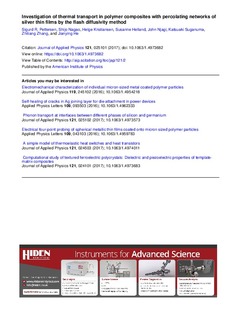Investigation of thermal transport in polymer composites with percolating networks of silver thin films by the flash diffusivity method
Pettersen, Sigurd Rolland; Nagao, Shijo; Kristiansen, Helge; Helland, Susanne; Njagi, John; Suganuma, Katsuaki; Zhang, Zhiliang; He, Jianying
Journal article, Peer reviewed
Published version

View/
Date
2017Metadata
Show full item recordCollections
Abstract
The flash diffusivity method, also known as laser flash analysis (LFA), is commonly used to obtain the thermal diffusivity (α) and thermal conductivity (κ) of materials, due to its relative simplicity, rapid measurements, small sample size requirement, and standardized commercially available instruments. In this work, an epoxy adhesive was filled with a large fraction of homogeneous micron-sized polymethylmethacrylate spheres coated with thin silver films, such that a percolating metallic network that dominated the electric and thermal transport formed through the polymer at <3 vol. % silver. Specific heat capacity (Cp) was measured from the LFA measurements by a comparative method and from the total and reversible heat flow signals of modulated differential scanning calorimetry (MDSC). κ was estimated as the product of α, Cp, and density (ρ) and was found to vary significantly with the method to find Cp. The electron contribution was found from the electrical conductivity by the Wiedemann–Franz law and was used to elucidate the thermal transport mechanisms in the composite. A theoretical background for the various methods is included.